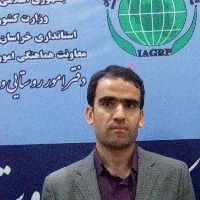Analysis the Impact of New Irrigation Systems on Rural Areas (Case Study: Mohammad Abad County, Anberabad Township)
Reducing water resources in the country and increasing water loss in different methods of irrigation have increased oriented the attention to pressurized irrigation, especially drip irrigation. One of the most suitable solutions for proper water resources management in the country is applying drip irrigation system in gardens. The village of Mohammad Abad is located in the central part of Anbarabad Township and has 15 villages. The main economic activity is horticultural practices there. Water losses due to soil evaporation are minimized in pressurized irrigation due to the decrease in the level of soil wetting, as well as the loss of water distribution in the air or soaking the foliage by this method. The use of this method reduces the growth of weeds and, consequently, unwanted water consumption by weeds, which ultimately affects the various aspects of rural life in the area. The purpose of this study was to investigate the effects of new irrigation systems on villagers in Mohammad Abad village. Therefore, this research sought to answer the question of what are the consequences of new irrigation systems in the rural areas of Mohammad Abad.
The research method was based on the applied objective and descriptive-analytic based on the method used. To collect the information in the theoretical part of the documentary resources, in the practical section, a survey method based on the distribution of the questionnaire and direct observation was used. The statistical population of the research was Mohammad Abad village with 15 villages, 1113 households and 5358 people. The four villages including 300 households and 955 people which employed modern irrigation systems were sampled. Next sampling was based on the number of households. According to the research facilities, 50% of households was selected as 150 households. Then, the questionnaires were distributed randomly among the households' supervisors of the village to the number specified, which was allocated according to the population of each village. In the present study, SPSS software was used to analyze the data and Pearson correlation coefficient and regression analysis and one-sample T-test were used to measure the variables. The information gathering tool was a researcher-made questionnaire.
Based on the results, the highest employment in the agriculture and horticulture sector was at 45.3%, which is due to the climate of the surveyed community, and the land inheritance laws. The lowest employment rate was in the administrative and service sector with an average of 5.3%. Moreover, according to the table below, 94.7% of owners have new and drip irrigation systems. Additionally, 13 items were considered to investigate the effect of new irrigation systems on villagers' life. All items were achieved a weighted average and higher score. According to the items studied, the target issue was related to increasing the household welfare (3.78), quantitative and qualitative products (3.76), increasing household welfare (3.78), improving quality of life (3.65), reducing the motivation of immigration (3.49) , increase in product quality (3.93), reduction of irrigation problems (4.48), water saving (4.49), increase in the economic situation of people (3.65), increase in production efficiency (3.78), return of immigrants (3.61), reclamation of abandoned lands (4.46) which all were above-average. Overall, the economic status as a general indicator with average of 3.90 was also above-average. In addition, there was a positive and significant correlation between all variables with new irrigation systems. Thus, new irrigation systems have had a positive impact on the improvement of all variables. The income increase, return of migrants and increase in efficiency of production seem to be more useful variables for predicting the rural population's economic status.
Based on the results, applying traditional irrigation increased irrigation costs and reduced the production efficiency and the quantity and quality of production in our studied region. Modern irrigation has had a positive effect on the economic and social condition of the villagers leading to increased revenues. Consequently, this has resulted in the restoration of the abandoned lands and the return of migrants. The results also show that the use of new irrigation systems, in addition to reducing water losses, will increase household income, product quality and the level of welfare and quality of life, reduce migration, and restore the deserted lands.
- حق عضویت دریافتی صرف حمایت از نشریات عضو و نگهداری، تکمیل و توسعه مگیران میشود.
- پرداخت حق اشتراک و دانلود مقالات اجازه بازنشر آن در سایر رسانههای چاپی و دیجیتال را به کاربر نمیدهد.



